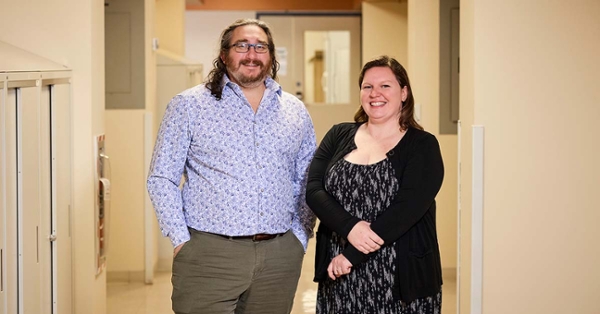$2M NIH grant backs research on brain cells, regions behind social behavior
$2M NIH grant backs research on brain cells, regions behind social behavior

Decades of research have shown that vasopressin, a chemical messenger in the brain, influences social behavior. With a five-year, $2,012,500 grant from the National Institutes of Health, Benjamin Rood, Ph.D., plans to use a new genetic tool that targets specific cells and regions of the brain to better understand this social behavior network.
The behavioral neuroscientist has spent years studying the influence of vasopressin on social behavior elsewhere in the brain. Now, Rood is pivoting his attention to a region called the mediodorsal thalamus.
“A lot of literature on social behavior has focused on a few specific brain regions,” said Rood, an assistant professor in the Rowan-Virtua School of Translational Biomedical Engineering & Sciences and the Rowan-Virtua School of Osteopathic Medicine, both part of Virtua Health College of Medicine & Life Sciences. “This is the first time anyone studying social behavior has focused on vasopressin-responsive cells in the thalamus, which is thought to be more specifically involved in cognitive behavior.”
Rood turned to his departmental colleague Elizabeth West, Ph.D., for her expertise in executive function and higher-order complex decision-making.
“In the context of social interaction, you need working memory and cognitive flexibility to change your behavior based on consequences,” said West, also an assistant professor and behavioral neuroscientist. “The behavioral tasks we're studying require these abilities.”
Social behavior is a response to stimuli in the environment—and it’s based on internal processes.
“A network of dozens of regions of the brain controls our sensory information, hormonal outputs and physiology,” Rood explained. “This pattern of how different brain regions communicate with each other brings about our behavior.”
To study how vasopressin acts on this specific brain region, Rood’s team will apply a multipronged approach. Daniel Chandler, Ph.D., also an assistant professor in the Department of Cell Biology & Neuroscience, will consult on the use of electrophysiology techniques to study the physiological properties of neurons.
Yong Chen, Ph.D., an assistant professor in the College of Science & Mathematics, will assist with RNA sequencing to identify the different cell types in the brain region and the genes they express. West’s expertise will allow the team to see how different neurons respond to stimuli during social interactions.
“This work has tremendous potential to understand cognitive behavior at the cellular level,” noted Mark Byrne, Ph.D., founding dean of Rowan-Virtua School of Translational Biomedical Engineering & Sciences. “Dr. Rood is leading an impressive scientific team that showcases Rowan’s expertise to tackle major problems in neuroscience.”
According to Rood, there is potential for applying enhanced knowledge of how these brain circuits work to improve human social interactions and health outcomes.
“We're going to discover more about the function of circuits that underlie social behavior and, ultimately, how our own brain works,” Rood said. “Understanding the circuitry of the brain allows us to inform clinical approaches, potentially using social behavior therapeutically to improve outcomes related to problem behaviors or more general health outcomes.”